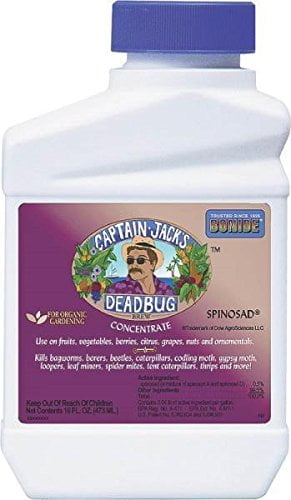

Use the product to soak the ground around plants that show signs of predation by pests. Use Captain Jack’s Dead Bug Brew to kill ants, aphids, thrips, beetles, larvae, caterpillars, leaf miners, and more. Use before or after the blooming cycle ends. For that reason, we recommend that it not be applied to plants or fruit trees that are in bloom. Spinosad has low toxicity to humans, and because it does not remain active for very long, it is ideal for handling most pest control issues in the garden.Ī word of warning about Captain Jack’s Dead Bug Brew: it will kill bees. The toxic levels of Spinosad breakdown in 8-24 hours, making this an excellent product for vegetable and fruit trees. The concentrated formula works well to kill insects that dwell in the ground and on plants. The main ingredient is Spinosad, which is a mixture of two chemicals produced by soil biota. Captain Jack’s Dead Bug BrewĬaptain Jack’s Dead Bug Brew is a broad-spectrum pesticide that features organic ingredients. Sluggo is an excellent example of a target-specific pesticide. Sluggo is organic and non-toxic to humans and pets. The ingredient in Sluggo breaks down into iron phosphate, which is naturally present in the soil. Some pesticides are very target-specific, such as Sluggo, a bait that snails and slug eat and then die. Reducing Pest Populations Before They Emergeīefore the flowers bloom and the plant awakens from winter, you can apply pesticides that reduce the number of pests around your yard. The adults lay their egg on the milkweed, the larvae hatch and then form a chrysalis (pupa), and then the adult emerges, and the cycle begins anew. They return when the weather is warm and use the milkweed plant to complete their lifecycle. An insect that does not is the Monarch butterfly. Many insects and invertebrates use the soil to protect them from winter. They hatch from an egg into larvae, pupate and then emerge as an adult.

In that way, they are not competing with each other for the same food source. The adult chafers feed on something different from the larvae.

That process is called resource partitioning. The adults will emerge as the roses begin to bloom. In the soil, you can find the larvae or the pupa during the winter. We don’t see them in the winter, but they are there. What all of this means for your garden or landscape is that you can knock back pest populations at certain times of the year before they become a devastating presence in your garden or yard.Īnother example of the insect lifecycle is the rose chafer beetles. Those stages we call “instars,” and they are part of the incomplete lifecycle process. Instead, they shed their exoskeleton several times until they reach adulthood. Most insects have a complete lifecycle, and others have an incomplete lifecycle. All of these organisms exist in your garden year-round. For the garden, the pest list includes stink bugs, aphids, ants, earwigs, spider mites, thrips, larvae, and non-insects, such as sowbugs. While butterflies and moths are excellent, in the caterpillar form, they are massively destructive, especially moth caterpillars. While we may not see the butterfly, it is present as an egg, a pupa, or caterpillar. That little fact is because of the lifecycle of insects. Plant-eating insects are around all year, even though we may not see them. Spring pest control sets the stage for the rest of the year.


 0 kommentar(er)
0 kommentar(er)
